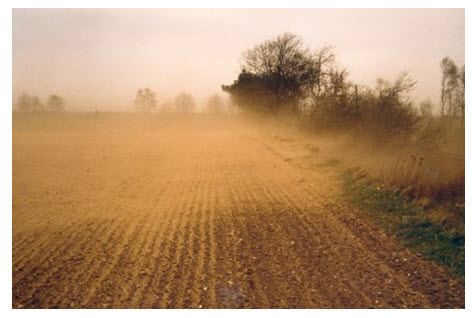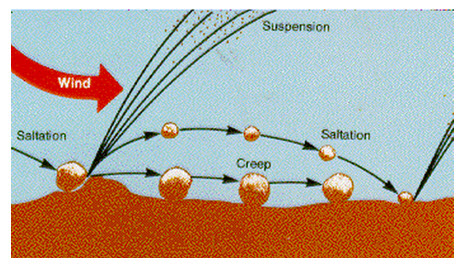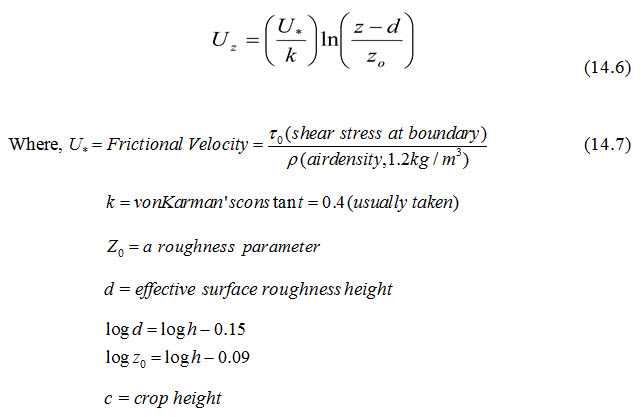Site pages
Current course
Participants
General
Module 1: Introduction and Concept of Soil Erosion
Module 2: Water Erosion and Control
Module 3: Wind Erosion, Estimation and Control
Module 4: Soil Loss- Sediment Yield Estimation
Module 5: Sedimentation
Module 6: Topographic Survey and Contour Maps
Module 7: Land Use Capability Classification
Module 8: Grassed Waterways
Module 9: Water Harvesting
Module 10: Water Quality and Pollution
Lesson 14 Wind Erosion and Its Estimation
14.1 Wind Erosion
Wind erosion is a serious environmental problem. It is in no way less severe than water erosion. High velocity winds strike the bare lands (having no cover), with increasing force. Fine, loose and light soil particles blown from the land surface are taken miles and miles away and thereby, causing a great damage to the crop productivity. It is a common phenomenon occurring mostly in flat, bare areas; dry, sandy soils; or anywhere the soil is loose, dry and finely granulated and where high velocity wind blows. Wind erosion, in India, is commonly observed in arid and semi-arid areas where the precipitation is inadequate, e.g. Rajasthan and some parts of Gujarat, Punjab and Haryana.
Wind erosion damages land and natural vegetation by removing soil from one place and depositing it at another location. It causes soil loss, dryness and deterioration of soil structure, nutrient and productivity losses and air pollution. Smaller particles of soil are more subject to movement by wind as silt, clay and organic matter are removed from the surface soil by strong wind, leaving the coarse, lesser productive material behind. Suspended dust and dirt are inevitably deposited over everything. It blows on and inside homes, covers roads and highways, and smothers crops. Sediment transport and deposition are significant factors in the geological changes which occur on the land around us and over long periods of time are important in the soil formation process. Most serious damage caused by wind erosion is the change in soil texture. Damage caused by wind erosion is demonstrated in Fig.14.1.

Fig. 14.1. An Illustration of Wind Erosion.
(Source: http://ecomerge.blogspot.in/2010/05/what-is-wind-erosion.html)
14.2 Factors Affecting Wind Erosion
Climate, soil and vegetation are the major factors affecting wind erosion at any particular location. The climatic factors that affect the wind erosion are the characteristics of wind itself (velocity and direction) in addition to the precipitation, humidity and temperature. Soil moisture conditions, texture, structure, density of particles, organic matter content are the soil characteristics that influence erosion by wind. Soil movement is initiated as a result of wind forces exerted against the surface of the ground. For each specific soil type and surface condition there is a minimum velocity required to move soil particles. This is called the threshold velocity. Once this velocity is reached, the quantity of soil moved is dependent upon the particle size, the cloddiness of particles, and wind velocity itself. Surface features like vegetation or other artificial cover (mulching etc) have the protective effect on wind erosion problem as surface cover increases the roughness over the land surface and thus reduces the erosive wind force on the land surface.
14.3 Mechanics of Wind Erosion
The overall occurrence of wind erosion could be described in three distinct phases. These are:
1. Initiation of Movement
2. Transportation
3. Deposition.
Movement of soil particles is caused by wind forces exerted against or parallel to the ground surface. The erosive wind is turbulent at all heights except very close to the surface. The lowest velocity occurs close to the ground and increases in proportion to the logarithm of the height above the surface. Soil particles or other projections on the surface absorb most of the force exerted by the wind on the surface. However, if the soil particles are lighter and loose, wind may lift them from the surface in the initiation process. A minimum threshold velocity (wind) is required to initiate the movement of soil particles. Thus, the threshold velocity is the minimum wind velocity needed to initiate the movement of soil particles. The magnitude of the threshold velocity is not fixed for all places and conditions but it varies with the soil conditions and nature of the ground surface. For example, for the most erodible soils of particle size about 0.1 mm; the required threshold velocity is 16 km/h at a height of 30 cm above the ground.
14.3.1 Initiation of Movement: The soil particles are first detached from their place by the impact and cutting action of wind. These detached particles are then ready for movement by the wind forces. After this initiation of movement, soil particles are moved or transported by distinct mechanisms.
14.3.2 Transportation: The transportation of the soil particles are of three distinct types and occur depending upon size of the soil particles. Suspension, saltation, and surface creep are the three types of soil movement or transport which occur during wind erosion. While soil can be blown away at virtually any height, the majority (over 93%) of soil movement/transportation takes place at or within one meter height from land surface. These transportation mechanisms of soil particles due to wind are shown in Fig. 14.2.

Fig. 14.2. Mechanics of Wind Erosion.
(Source: http://commons.wikimedia.org/wiki/File:Saltation-mechanics.gif)
14.3.3 Suspension: It occurs when very fine dirt and dust particles are lifted into the atmosphere. They can be thrown into the air through impact with other particles or by the wind itself. These particles can be carried very high and be transported over very long distances in the atmosphere by the winds. Soil moved by suspension is the most spectacular and easiest to recognize among the three forms of movement. The soil particles of less than 0.1 mm size are subjected to suspension and around 3 to 40 % of soil weights are carried by the suspension method of soil transport under the wind erosion.
14.3.4 Saltation: The major fraction of soil moved by the wind is through the process of saltation. Saltation movement is caused by the pressure of the wind on soil particles as well as by the collision of a particle with other particles. Soil particles (0.1 to 0.5 mm) move in a series of bounces and/or jumps. Fine soil particles are lifted into the air by the wind and drift horizontally across the surface increasing in velocity as they move. Soil particles moved in the process of saltation can cause severe damage to the soil surface and vegetation. They travel approximately four times longer in distance than in height. When they strike the surface again they either bounce back into the air or knock other soil particles from the soil mass into the air. Depending on soil type, about 50 to 75% of the total weight of soil is carried in saltation. The height of the jump varies with the size and density of the soil particles, the roughness of the soil surface, and the velocity of the wind.
14.3.5 Surface Creep: The large particles which are too heavy to be lifted into the air are moved through a process called surface creep. In this process, the particles are rolled across the surface after coming into contact with the soil particles in saltation. In this process the largest of the erosive particles having diameters between 0.5 to 2 mm are transported and around 5 to 25% of the total soil weights are carried in this fashion. Overall, the mass of soil moved by wind is influenced primarily by particle size, gradation of particles, wind velocity and the distance along the eroding area. Winds being variable in velocity and direction produce eddies and cross-currents that lift and transport soil. The amount of soil moved/transported depends on the median particles (soil) diameter and the difference in threshold and actual wind velocity. The mass of soil moved can be related to the influencing parameters by the following equation:
Quantity of soil moved (V – Vth)3 / D0.5
where V = wind velocity, Vth = threshold velocity, and D = particle diameter.
14.3.6 Deposition: Deposition of soil particles occurs when the gravitational force is greater than the forces holding the particle in the air. This generally happens when there is a decrease in the wind velocity caused by vegetative or other physical barriers like ditches or benches. Raindrops may also take dust out of air.
14.4 Estimation of Soil Loss Due to Wind Erosion
An equation in the form of universal soil loss equation has been developed and can be used for estimating soil loss by wind. However, the evaluation of the constants in the equation for wind erosion is comparatively difficult than the universal soil loss equation. The equation is of the form,
![]() (14.1)
(14.1)
Where, E is soil loss by wind erosion, I is soil cloddiness factor, R is surface cover factor, K is surface roughness factor, F is soil textural class factor, C is factor representing local wind condition, D is wind direction factor, and B is wind barrier factor, W is field width factor.
Another model of wind erosion estimation used in USA is as follows:
![]() (14.2)
(14.2)
Where, E is estimated average annual soil loss (t/ha/yr), I is soil erodibility index (t/ha-yr), K is ridge roughness factor, C is climate factor, L is unsheltered length of eroding field (m), and V is vegetative cover factor.
The soil erodibility index (I) can be estimated as given below
![]() (14.3)
(14.3)
Where, F is % of dry soil fraction greater than 0.84 mm, K is ridge roughness factor; a measure of ridges made by tillage implements on wind erosion and can be estimated as given below
 (14.4)
(14.4)
Where, Kr is ridge roughness, h is ridge height in mm, d is ridge spacing in mm, and K can be estimated as a function of ridge roughness.
 (14.5)
(14.5)
The climatic factor (C) depends on wind velocity and soil surface moisture. The mean wind velocity profile above the soil surface is estimated as given below.

Solved Problem:
Find out the wind velocity at 10 and 15 m height from ground surface over a wheat cropped field of plants height 1.3 m and friction velocity of 6 m/s.
Solution: The mean wind velocity above the soil surface is estimated as-

Given: frictional velocity (Uz) = 6 m/s
Plants height of wheat cropped field = 1.3 m (h)
z = 10 and 15 m,

Estimating d and z0
log d = log(1.3) - 0.15 = -0.03606
d = 0.92033 m
log z0 = log(1.3) - 0.09 = -0.023943
z0 = 1.05668 m
Now: U10 = 32.26359 m/s, and U15 = 38.84401 m/s.
Keywords: Wind Erosion, Soil Loss Equation, Mechanics of Wind Erosion, Initiation of Movement, Transportation, Deposition.
References
Portland State University, URL: http://ecomerge.blogspot.in/2010/05/what-is-wind-erosion.html
Wikipedia Commons, URL: http://commons.wikimedia.org/wiki/File:Saltation-mechanics.gif
Suggested Readings
Murthy, V.V.N. and Jha, M.K. (2011). Land and Water Management Engineering. Kalyani Publications. New Delhi.